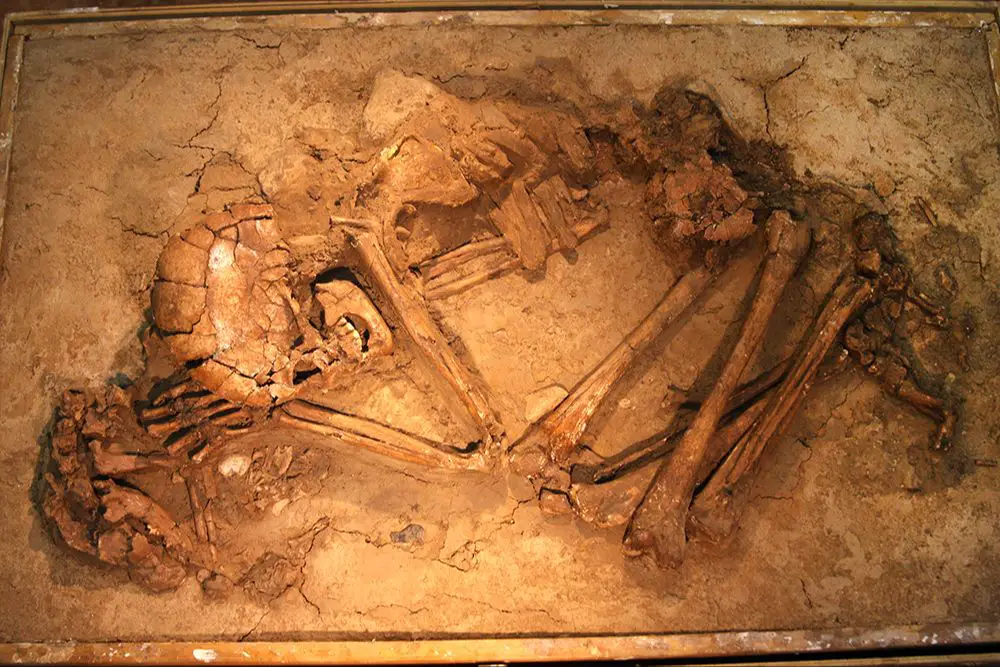Introduction
The question of whether cats or dogs were first domesticated by humans is an interesting one. Domestication refers to the process by which wild animals were tamed over many generations to live alongside humans. The domestication of cats and dogs represented major milestones in human history, as these animals provided companionship, security, and assistance with hunting and tasks. When and where cats and dogs were first domesticated has been debated by historians and scientists alike.
In examining which animal humans lived with first, two key questions need to be answered: 1) When did the domestication of dogs versus cats first occur? 2) Where did these domestication events take place? Archaeological and genetic evidence provides clues that shed light on the approximate timelines and locations of early cat and dog domestication. By comparing the data on early dog and cat domestication, we can begin to piece together which animal humans lived with first.
Early Evidence of Dog Domestication
Archaeological evidence indicates that dogs were likely the first domesticated animal. Burials of dogs alongside humans date back over 14,000 years to the late Paleolithic period. One notable example is a dog burial in Germany that dates back 14,200 years. The dog was found buried with humans and was likely a domesticated wolf or dog based on its smaller size compared to wolves of the time. Other Paleolithic dog burials have been found in Russia, the Czech Republic, and Belgium.

These burials show that there was likely a close bond between humans and dogs dating back to the late Stone Age. The fact that dogs were buried alongside humans indicates they held a special place in human society. DNA analysis of ancient dog remains also reveals that dogs genetically diverged from wolves around 15,000 years ago during the late Paleolithic. This evidence points to dogs being domesticated long before any other animal and that they have been human companions for thousands of years.
Genetic Studies on Dog Domestication
Genetic analysis provides scientific evidence for theories on dog domestication timelines and ancestry. By sequencing the genomes of modern dogs and wolves, scientists found genetic divergence estimates ranging from 11,000 to 16,000 years ago. This indicates dogs likely split from gray wolves at the end of the last ice age when hunter gatherers were transitioning into agricultural societies.
Another genetic study compared DNA from ancient dog remains to modern canines. The ancient dog genomes showed a closer genetic relationship to modern dogs than wolves, even when the dog remains were over 4,000 years old. This demonstrates modern dogs are direct descendants of the earliest proto-dogs. Genetic evidence clearly points to a single domestication event between humans and wolves thousands of years ago, resulting in the dogs we know today.
Possible Origins of Dog Domestication
There are two leading theories on where and why dogs were first domesticated:
The first theory suggests that dogs were domesticated in East Asia by hunter-gatherers over 15,000 years ago. Proponents argue that wolves likely started scavenging around human camps for food scraps. Over time, hunters may have captured and tamed wolf pups, eventually breeding them into early dogs. The close proximity and food source offered by human camps gave certain wolves an evolutionary advantage in becoming domesticated.
The second major theory contends that dog domestication originated in Western Eurasia around 20,000-40,000 years ago. According to this view, humans camping in cold climates benefited from tamed wolves that could provide warmth, companionship, hunting assistance, and warning of dangers at night. As human tribes became more settled, proto-dogs were further bred for skills like herding, protecting property, and killing vermin.
In summary, most evidence suggests dogs were likely first domesticated during the hunter-gatherer phase of human history, drawn to early human camps and settlements. Through selective breeding over thousands of years, companionship and work roles gradually transformed wild wolves into the diverse dog breeds we know today.
Early Evidence of Cat Domestication
Archaeological evidence suggests that cats were first domesticated in the Near East around 10,000 years ago. The earliest known evidence comes from a 9,500 year old Neolithic village called Shillourokambos in Cyprus. Excavations at this site uncovered a human burial containing a cat laid across the human’s chest. The cat skeleton showed signs that it had been buried intentionally, suggesting some sort of emotional bond with humans.

Other early evidence of cat domestication comes from ancient Egypt around 4,000 years ago. Egyptian artwork depicts images of cats assisting with rodent control and cat mummies buried alongside human remains. Analyses of the cat mummies indicates they were likely domesticated cats rather than wildcats. The archaeological record also shows that the ancient Egyptians had cat collars, toys and even kitty litter boxes – indicating they kept them as pets. From Egypt, domesticated cats gradually spread to other parts of the Near East and Europe through trade and human migration.
Genetic Studies on Cat Domestication
Genetic analysis provides key insights into when and how cats became domesticated. Researchers have compared the DNA of ancient cat remains to modern domestic cats and their wild counterparts. Several studies show that domestic cats genetically diverged from the Near Eastern wildcat (Felis silvestris lybica) around 10,000 to 15,000 years ago in the Fertile Crescent region of the Near East.
One study sequenced the genomes of over 200 cats, including ancient Egyptian cat mummies. They found that these ancient cats were genetically similar to Near Eastern wildcats. However, they also carried genetic mutations linked to domestication, like genes for docility and coat variations. The age of these mummies suggests cats had begun the domestication process around 15,000 years ago.
Another extensive study examined mitochondrial DNA from over 2000 modern cats worldwide. The results showed that the maternal DNA lineages of domestic cats trace back to at least five wildcat populations in the Near East/Eastern Mediterranean region. This points to multiple domestication events between the wildcat populations and early human settlements in these areas around 10,000 years ago.
Overall, genetic evidence indicates that cats started becoming domesticated in the Near East several thousand years after the earliest evidence of dog domestication. While dogs appear to descend from East Asian wolves, cats were domesticated from wildcats native to the Near East and Egypt. This mirrors the independent trajectories seen in other domesticated animals like pigs, cattle, and goats.
Possible Origins of Cat Domestication
Leading theories suggest that cats were first domesticated in the Near East around 10,000 to 12,000 years ago. As humans transitioned to agricultural societies, rodents likely became more abundant around stored grains. This created an opportunity for a symbiotic relationship between humans and cats. Cats could help control rodent populations around human settlements in exchange for food and shelter. The earliest known evidence of tamed cats comes from an archaeological site in Cyprus that dates back over 9,500 years. Cats were also sacred animals in ancient Egypt, suggesting they had a longstanding relationship with humans. Genetic studies indicate that the Near Eastern wildcat is the primary ancestor of domestic cats. Overall, the evidence suggests cats were first domesticated in the Near East to help control rodents, and this mutualistic relationship enabled the spread of cats across the ancient world.
Comparing Dog and Cat Timelines
When comparing the evidence for early dog and cat domestication, it appears dogs were domesticated significantly earlier than cats. Genetic studies indicate the first domestication of dogs began over 15,000 years ago. In contrast, the earliest evidence for cat domestication only dates back 9,000-10,000 years.

This suggests humans lived with domesticated dogs for thousands of years before domestic cats appeared. Some of the earliest undisputed dog remains come from Eurasian sites dated around 14,000-16,000 years ago. Clear archaeological evidence for cats only appears between 4,000-9,500 years ago in early agricultural settlements in the Middle East.
So while both species were domesticated during the Neolithic period when humans transitioned from hunter-gatherers to farmers, dogs were successfully domesticated during the Paleolithic era long before the advent of agriculture. This gave dogs a head start of at least 5,000 years over cats as companion animals.
Why the Order Matters
The order in which humans domesticated dogs and cats has interesting implications. Dogs were likely the first animal humans domesticated, perhaps as early as 40,000 years ago. This means dogs have been companions to humans through our entire recorded history. Some theories suggest early humans may have partnered with dogs for hunting or protection. This could indicate dogs played an important role in our evolutionary success as a species.

In contrast, the earliest evidence of cat domestication only dates back 9,000-10,000 years ago. This means for at least 30,000 years of human evolution and history, dogs were our primary animal companions while cats remained undomesticated. One theory is that cats were not domesticated until humans began agriculturally based, settled civilizations. Once humans began storing grain, it attracted rodents, which in turn attracted wild cats. Humans may have then adopted and bred the most docile cats as a form of natural pest control.
So while both species have a long history with humans, dogs have been by our side for far longer. This may contribute to the closer emotional bond humans often share with dogs compared to cats. The early domestication of dogs also means they likely coevolved alongside humans in a deep, symbiotic way cats did not. So the order provides insight into each animal’s changing evolutionary pressures and relationships with humans over time.
Conclusion
The available archaeological and genetic evidence indicates that dogs were domesticated first, at least 15,000 years ago. Cats followed much later, with evidence of cat domestication only appearing around 10,000-9,500 years ago in the Near East. Both dogs and cats lived around humans as commensal animals, benefitting from proximity to human food waste, before gradually being domesticated.
Dogs appear to have been intentionally bred and kept by humans for tasks like hunting, guarding, and companionship. With cats, the process was more gradual and natural, as wild cats self-domesticated by adapting to human settlements for easy access to rodents.
While the timeline is clear, many details remain unknown. We lack consensus on the precise origins of cat and dog domestication, and it’s likely both processes occurred across multiple early human societies. Ongoing research and discoveries continue to reveal new insights into our long history with these familiar yet fascinating animals.